🔭🌃🌌🍂🍁🐈
🔭🌃🌌🍂🍁🐈
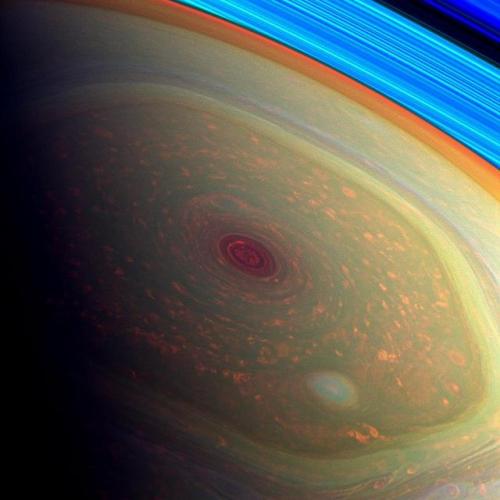
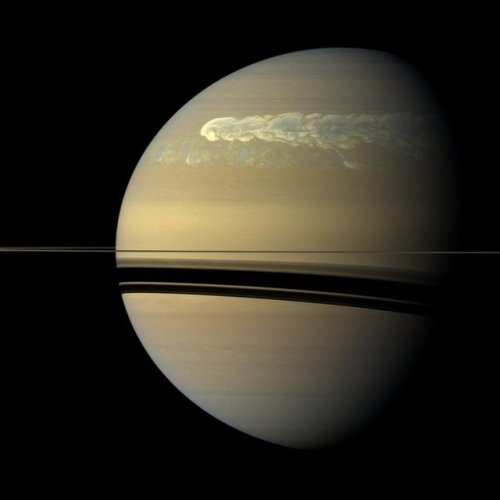
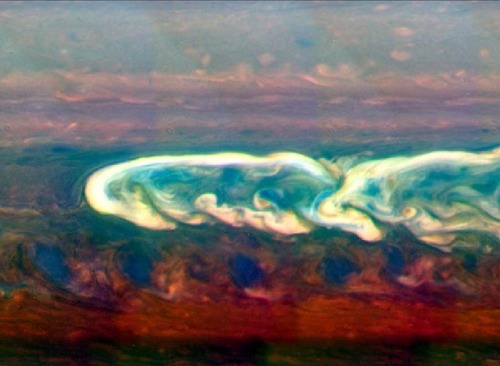



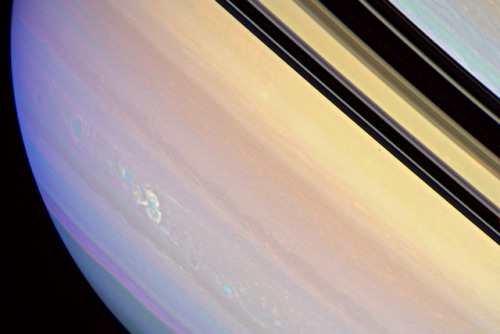

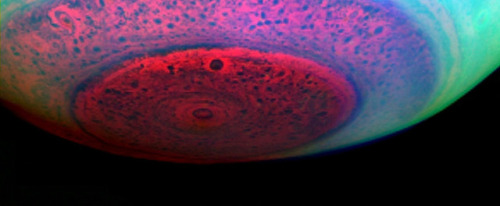
Saturn’s atmosphere exhibits a banded pattern similar to Jupiter’s, but Saturn’s bands are much fainter and are much wider near the equator. The nomenclature used to describe these bands is the same as on Jupiter. Saturn’s finer cloud patterns were not observed until the flybys of the Voyager spacecraft during the 1980s. Since then, Earth-based telescopy has improved to the point where regular observations can be made. The composition of the clouds varies with depth and increasing pressure.
The winds on Saturn are the second fastest among the Solar System’s planets, after Neptune’s. Voyager data indicate peak easterly winds of 500 m/s (1,800 km/h).
Thermography has shown that Saturn’s south pole has a warm polar vortex, the only known example of such a phenomenon in the Solar System. Whereas temperatures on Saturn are normally −185 °C, temperatures on the vortex often reach as high as −122 °C, suspected to be the warmest spot on Saturn.
Credit: NASA/JPL-Caltech/Space Science Institute and Kevin M. Gill
More Posts from Monstrous-mind and Others
🌄🍁🍂🎃🍂🍁🐾🐈

🍃🍁🍂🎃🍂🍁
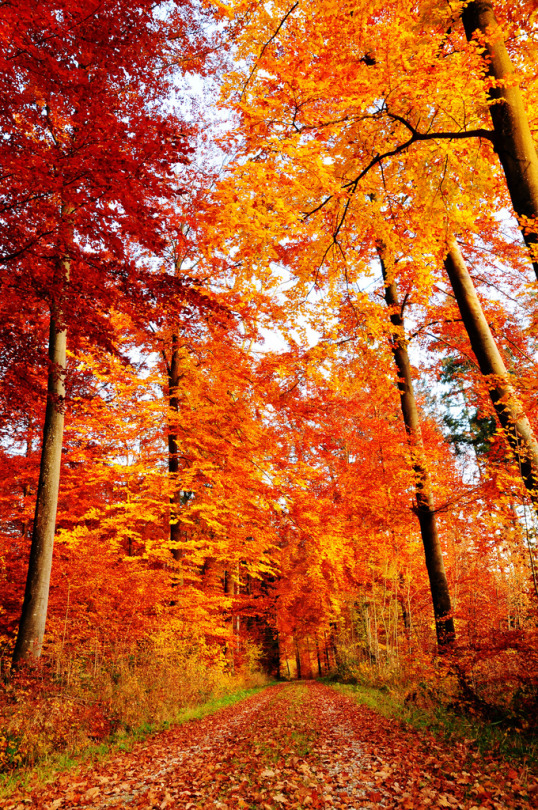
What's Up - December 2017
What’s Up For December? Geminid and Ursid meteor showers & winter constellations!

This month hosts the best meteor shower of the year and the brightest stars in familiar constellations.

The Geminds peak on the morning of the 14th, and are active from December 4th through the 17th. The peak lasts for a full 24 hours, meaning more worldwide meteor watchers will get to see this spectacle.

Expect to see up to 120 meteors per hour between midnight and 4 a.m. but only from a dark sky. You’ll see fewer after moonrise at 3:30 a.m. local time.

In the southern hemisphere, you won’t see as many, perhaps 10-20 per hour, because the radiant never rises above the horizon.

Take a moment to enjoy the circle of constellations and their brightest stars around Gemini this month.

Find yellow Capella in the constellation Auriga.

Next-going clockwise–at 1 o'clock find Taurus and bright reddish Aldebaran, plus the Pleiades.

At two, familiar Orion, with red Betelguese, blue-white Rigel, and the three famous belt stars in-between the two.

Next comes Leo, and its white lionhearted star, Regulus at 7 o'clock.

Another familiar constellation Ursa Major completes the view at 9 o'clock.

There’s a second meteor shower in December, the Ursids, radiating from Ursa Minor, the Little Dipper. If December 22nd and the morning of December 23rd are clear where you are, have a look at the Little Dipper’s bowl, and you might see about ten meteors per hour. Watch the full What’s Up for December Video:
There are so many sights to see in the sky. To stay informed, subscribe to our What’s Up video series on Facebook. Make sure to follow us on Tumblr for your regular dose of space: http://nasa.tumblr.com.

The NASA/ESA Hubble Space Telescope captures the iridescent tapestry of star birth in a neighbouring galaxy in this panoramic view of glowing gas, dark dust clouds, and young, hot stars.
Credit: NASA/ESA and the Hubble Heritage Team (AURA/STScI/HEIC)
🍁🍂🎃🍂🍁

Waiting for autumn leaves to start falling down again. 🍁
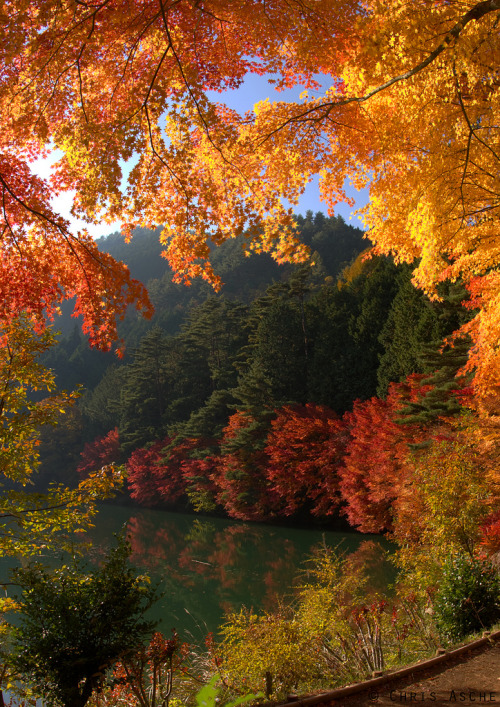
gateway to autumn (via All sizes | Gate to Autumn | Flickr - Photo Sharing!)

Autumn Path by AnthonyPresley
🔭🌃🌌
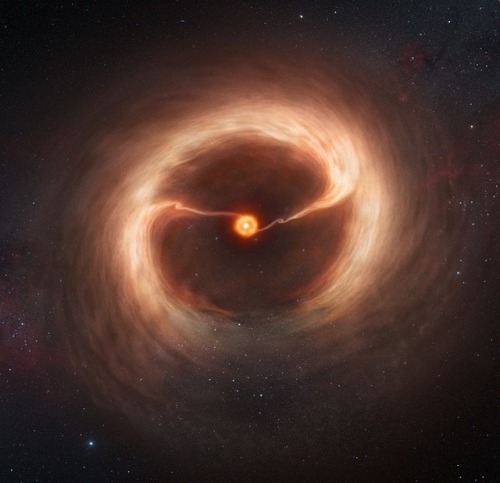
This artist’s impression shows the disc of gas and cosmic dust around the young star HD 142527. Astronomers using the Atacama Large Millimeter/submillimeter Array (ALMA) telescope have seen vast streams of gas flowing across the gap in the disc. These are the first direct observations of these streams, which are expected to be created by giant planets guzzling gas as they grow, and which are a key stage in the birth of giant planets.
Credit: ESO / Atacama Large Millimeter/submillimeter Array
🔭🌌🪐

Saturn - March 11 2006
Image Credit: NASA/JPL-Caltech/CCI/CICLOPS/Kevin M. Gill
🦡🦨🦕🦖🦴

Research alert! Two new fossils of a mouse-sized animal from the age of dinosaurs indicate that early mammals grew more slowly and lived longer than their modern descendants—rewriting our understanding of the lives of the very earliest mammals. An international study led by researchers at National Museums Scotland and published today in the journal Nature, compares two Krusatodon kirtlingtonensis fossils discovered decades apart in Scotland’s Isle of Skye. One of the fossils, the only juvenile Jurassic mammal skeleton known to science, was discovered in 2016 by Roger Benson, the Museum’s Macaulay Curator in the Division of Paleontology, and colleagues.
“These fossils are among the most complete mammals from this time period in the world,” said Elsa Panciroli, the lead author of the study and an associate researcher of paleobiology at National Museums Scotland.
Learn how these small animals give us unprecedented insights into the lives of early mammals.
Image: © Maija Karala
-
 zencat22-blog liked this · 1 month ago
zencat22-blog liked this · 1 month ago -
 dangdangrevolution liked this · 2 months ago
dangdangrevolution liked this · 2 months ago -
 maskythedefault liked this · 8 months ago
maskythedefault liked this · 8 months ago -
 maskythedefault reblogged this · 8 months ago
maskythedefault reblogged this · 8 months ago -
 gueule-de-contact liked this · 8 months ago
gueule-de-contact liked this · 8 months ago -
 warcotuj8746 liked this · 8 months ago
warcotuj8746 liked this · 8 months ago -
 der-macau-kaiman liked this · 9 months ago
der-macau-kaiman liked this · 9 months ago -
 crucrionnia reblogged this · 11 months ago
crucrionnia reblogged this · 11 months ago -
 archangelic-aeon reblogged this · 1 year ago
archangelic-aeon reblogged this · 1 year ago -
 darffy liked this · 1 year ago
darffy liked this · 1 year ago -
 vicissitudeislove liked this · 1 year ago
vicissitudeislove liked this · 1 year ago -
 caffeinsanity liked this · 1 year ago
caffeinsanity liked this · 1 year ago -
 gamelpar liked this · 1 year ago
gamelpar liked this · 1 year ago -
 cocogold333-blog liked this · 1 year ago
cocogold333-blog liked this · 1 year ago -
 vortexanomaly reblogged this · 1 year ago
vortexanomaly reblogged this · 1 year ago -
 vortexanomaly liked this · 1 year ago
vortexanomaly liked this · 1 year ago -
 virginlibertine reblogged this · 1 year ago
virginlibertine reblogged this · 1 year ago -
 virginlibertine liked this · 1 year ago
virginlibertine liked this · 1 year ago -
 theycannotfindmenow liked this · 1 year ago
theycannotfindmenow liked this · 1 year ago -
 the-pastoralist reblogged this · 1 year ago
the-pastoralist reblogged this · 1 year ago -
 baddestvenus-in-virgo reblogged this · 1 year ago
baddestvenus-in-virgo reblogged this · 1 year ago -
 baddestvenus-in-virgo liked this · 1 year ago
baddestvenus-in-virgo liked this · 1 year ago -
 itfamromacor liked this · 1 year ago
itfamromacor liked this · 1 year ago -
 misterrmayor reblogged this · 1 year ago
misterrmayor reblogged this · 1 year ago -
 linelcnastyde liked this · 1 year ago
linelcnastyde liked this · 1 year ago -
 nightwavezs liked this · 1 year ago
nightwavezs liked this · 1 year ago -
 leerraeume reblogged this · 1 year ago
leerraeume reblogged this · 1 year ago -
 ravexandxlust liked this · 1 year ago
ravexandxlust liked this · 1 year ago -
 darkwindows24 liked this · 1 year ago
darkwindows24 liked this · 1 year ago -
 wonlicirpho liked this · 1 year ago
wonlicirpho liked this · 1 year ago -
 clitorsaurusex reblogged this · 1 year ago
clitorsaurusex reblogged this · 1 year ago -
 hamcubes reblogged this · 1 year ago
hamcubes reblogged this · 1 year ago -
 outsiderblues liked this · 1 year ago
outsiderblues liked this · 1 year ago
My ambition is handicapped by laziness. -C. Bukowski Me gustan las personas desesperadas con mentes rotas y destinos rotos. Están llenos de sorpresas y explosiones. -C. Bukowski. I love cats. Born in the early 80's, raised in the 90's. I like Nature, Autumn, books, landscapes, cold days, cloudy Windy days, space, Science, Paleontology, Biology, Astronomy, History, Social Sciences, Drawing, spending the night watching at the stars, Rick & Morty. I'm a lazy ass.
222 posts